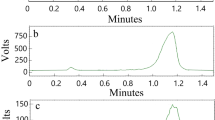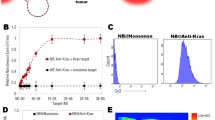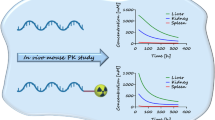Abstract
Purpose
We aimed to explore the feasibility of transfection methods for antisense imaging.
Procedures
Antisense oligonucleotides (ASON) targeted to the mRNA of hTERT gene were synthesized and labeled with Technetium-99m and fluorescein isothiocyanate (FITC), respectively. Then, ASON was combined with transfection reagent Lipofectamine 2000 and XfectTM, named Lipo-ASON and Xfect-ASON, respectively. After transfection, the labeled ASON was characterized in hNPCs-G3 and hRPE cells. Reverse transcription polymerase chain reaction (RT-PCR) and Western blotting were performed to assay the hTERT mRNA and protein levels after hNPCs-G3 cells were incubated with Lipo-ASON, Xfect-ASON, and naked ASON. In addition, Lipo-ASON, Xfect-ASON, and naked ASON were injected into tumor-bearing mice, and the biodistribution in vivo was performed.
Results
The presence of two transfection reagents significantly increased intracellular uptake of radiolabeled ASON in both cell lines compared with naked ASON (p < 0.05). However, there was no significant difference in cellular uptake rates of Lipo-ASON and Xfect-ASON between hNPCs-G3 and hRPE cells. In comparison with naked ASON, the fluorescence intensity was strongly enhanced after binding to transfection reagents. Furthermore, the levels of hTERT mRNA and protein were significantly reduced in cells treated with Lipo-ASON and Xfect-ASON (p < 0.05), but naked ASON had no significant effect on hTERT expression level. The biodistribution study indicated that tumor radioactivity uptake of radiolabeled ASON for naked ASON, Lipo-ASON, and Xfect-ASON group was low and shown no significant difference in vivo.
Conclusions
Lipofectamine transfection and XfectTM transfection were not effective delivery methods of ASON for antisense imaging.




Similar content being viewed by others
References
Massoud TF, Gambhir SS (2003) Molecular imaging in living subjects: seeing fundamental biological processes in a new light. Genes Dev 17:545–580
Dewanjee MK, Ghafouripour AK, Kapadvanjwala M et al (1994) Noninvasive imaging of c-myc oncogene messenger RNA with Indium-1l-antisense probes in a mammary tumor-bearing mouse model. J Nucl Med 35:1054–1063
Hnatowich D, Winnard P Jr, Virzi F et al (1995) Labeling deoxyribonucleic acid oligonucleotides with 99mTc. J Nucl Med 36:2306–2314
Shi N, Boado RJ, Pardridge WM (2000) Antisense imaging of gene expression in the brain in vivo. Proc Nat Acad Sci 97:14709–14714
Opalinska JB, Gewirtz AM (2002) Nucleic acid therapeutics: basic principles and recent applications. Nat Rev Drug Discov 1:503–514
Kole R, Krainer AR, Altman S (2012) RNA therapeutics: beyond RNA interference and antisense oligonucleotides. Nat Rev Drug Discov 11:125–140
Visser ME, Witztum JL, Stroes ES, Kastelein JJ (2012) Antisense oligonucleotides for the treatment of dyslipidaemia. Eur Heart J ehs084
Southwell AL, Skotte NH, Bennett CF, Hayden MR (2012) Antisense oligonucleotide therapeutics for inherited neurodegenerative diseases. Trends Mol Med 18:634–643
Gutschner T, Hammerle M, Eissmann M et al (2013) The long non-coding RNA MALAT1 is an essential gene regulator for lung cancer metastasis in a novel human knockout model. Cancer Res 73:1121
Kamimura K, Suda T, Zhang G, Liu D (2011) Advances in gene delivery systems. Pharm Med 25:293–306
Zobel H-P, Junghans M, Maienschein V et al (2000) Enhanced antisense efficacy of oligonucleotides adsorbed to monomethylaminoethylmethacrylate methylmethacrylate copolymer nanoparticles. Eur J Pharm Biopharm 49:203–210
Vinogradov S, Batrakova E, Kabanov A (1999) Poly (ethylene glycol)–polyethyleneimine NanoGel™ particles: novel drug delivery systems for antisense oligonucleotides. Colloids Surf B Biointerfaces 16:291–304
Zelphati O, Szoka FC Jr (1996) Liposomes as a carrier for intracellular delivery of antisense oligonucleotides: a real or magic bullet? J Control Release 41:99–119
Pakunlu RI, Wang Y, Saad M, Khandare JJ, Starovoytov V, Minko T (2006) In vitro and in vivo intracellular liposomal delivery of antisense oligonucleotides and anticancer drug. J Control Release 114:153–162
Fu P, Shen B, Zhao C, Tian G (2010) Molecular imaging of MDM2 messenger RNA with 99mTc-labeled antisense oligonucleotides in experimental human breast cancer xenografts. J Nucl Med 51:1805–1812
Liu M, Wang RF, Yan P, Zhang CL, Cui YG (2014) Molecular imaging and pharmacokinetics of 99mTc‐hTERT antisense oligonucleotide as a potential tumor imaging probe. J Label Compd Radiopharm 57:97–101
Koo OM, Rubinstein I, Onyuksel H (2005) Role of nanotechnology in targeted drug delivery and imaging: a concise review. Nanomedicine: Nanotechnol Biol Med 1:193–212
Lambert G, Fattal E, Couvreur P (2001) Nanoparticulate systems for the delivery of antisense oligonucleotides. Adv Drug Deliv Rev 47:99–112
Peddada LY, Garbuzenko OB, Devore DI, Minko T, Roth CM (2014) Delivery of antisense oligonucleotides using poly (alkylene oxide)–poly (propylacrylic acid) graft copolymers in conjunction with cationic liposomes. J Control Release 194:103–112
Brown PK, Qureshi AT, Hayes DJ, Monroe WT (2011) Targeted gene silencing with light and a silver nanoparticle antisense delivery system [abstract]. 573-574P
Rudin CM, Marshall JL, Huang CH et al (2004) Delivery of a liposomal c-raf-1 antisense oligonucleotide by weekly bolus dosing in patients with advanced solid tumors: a phase I study. Clin Cancer Res 10:7244–7251
Koslowsky I, Shahhosseini S, Mirzayans R et al (2011) Evaluation of an 18F-labeled oligonucleotide probe targeting p21(WAF1) transcriptional changes in human tumor cells. Oncol Res Featuring Preclin Clin Cancer Ther 19:265–274
Zhang Y-M, Rusckowski M, Liu N et al (2001) Cationic liposomes enhance cellular/nuclear localization of 99mTc-antisense oligonucleotides in target tumor cells. Cancer Biother Radiopharm 16:411–419
Kraemer K, Fuessel S, Schmidt U et al (2003) Antisense-mediated hTERT inhibition specifically reduces the growth of human bladder cancer cells. Clin Cancer Res 9:3794–3800
Beltinger C, Saragovi H, Smith R et al (1995) Binding, uptake, and intracellular trafficking of phosphorothioate-modified oligodeoxynucleotides. J Clin Invest 95:1814
Zelphati O, Szoka FC (1996) Mechanism of oligonucleotide release from cationic liposomes. Proc Nat Acad Sci 93:11493–11498
Crooke RM, Graham MJ, Cooke ME, Crooke ST (1995) In vitro pharmacokinetics of phosphorothioate antisense oligonucleotides. J Pharmacol Exp Ther 275:462–473
Hnatowich DJ, Nakamura K (2004) Antisense targeting in cell culture with radiolabeled DNAs—a brief review of recent progress. Ann Nucl Med 18:363–368
Hnatowich DJ (1999) Antisense and nuclear medicine. J Nucl Med 40:693–703
Liu M, Wang RF, Zhang CL et al (2007) Noninvasive imaging of human telomerase reverse transcriptase (hTERT) messenger RNA with 99mTc-radiolabeled antisense probes in malignant tumors. J Nucl Med 48:2028–2036
Zheng J-G, Tan T-Z (2004) Antisense imaging of colon cancer-bearing nude mice with liposome-entrapped 99m-technetium-labeled antisense oligonucleotides of c-myc mRNA. World J Gastrolenterol 10:2563–2566
Acknowledgments
This study was supported by the Natural Science Foundation of Hainan Province (814328). We wish to express our warm thanks to Fenghe (Shanghai) Information Technology Co., Ltd. Their ideas and help gave a valuable added dimension to our research.
Conflict of Interest
The authors declare that they have no conflict of interest.
Author information
Authors and Affiliations
Corresponding author
Additional information
Chang-bin Liu and Jun-qing Xu are co-first authors.
Highlights
Carrier-mediated delivery systems enhanced cellular uptake of ASON in vitro.
Carrier-mediated delivery systems resulted in low target/non-target ratios.
Transfection reagents were useless for the cellular uptake of ASON in vivo.
Rights and permissions
About this article
Cite this article
Liu, Cb., Xu, Jq., Xu, Bx. et al. Can Carrier-Mediated Delivery System Promote the Development of Antisense Imaging?. Mol Imaging Biol 17, 625–632 (2015). https://doi.org/10.1007/s11307-015-0827-7
Published:
Issue Date:
DOI: https://doi.org/10.1007/s11307-015-0827-7




